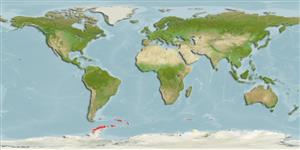Classification / Names
Common names from other countries
Main reference
Size / Weight / Age
Max length : 55.0 cm TL male/unsexed; (Ref. 5179); common length : 40.0 cm TL male/unsexed; (Ref. 2121)
Length at first maturity
Lm 37.7 range ? - ? cm
Environment
Marine; demersal; depth range 6 - 429 m (Ref. 11892)
Climate / Range
Polar, preferred 2°C (Ref. 107945); 53°S - 67°S, 75°W - 75°E
Distribution
Southern Ocean: Scotia Arc and Heard Island. Also distributed in the South Atlantic, near the southern Shetland, southern Sandwich, southern Orkney Islands, and near South Georgia Island (Ref. 4883).
Countries | FAO areas | Ecosystems | Occurrences | Introductions
Short description
Dorsal
spines
(total): 6 - 8;
Dorsal
soft rays
(total): 31-34;
Anal
soft rays: 31 - 34. Upper part of head and body irregularly spotted and blotched. Rarely with traces of darker cross-bars, young with irregular cross-bars, broken up into three or four series of alternating spots (Ref. 11892).
IUCN Red List Status (Ref. 115185)
Threat to humans
Harmless
Human uses
Fisheries: minor commercial
Tools
Special reports
Download XML
Internet sources
Estimates of some properties based on models
Phylogenetic diversity index
PD50 = 0.5312 many relatives (e.g. carps) 0.5 - 2.0 few relatives (e.g. lungfishes)
Trophic Level
3.3 ±0.2 se; Based on diet studies.
Resilience
Low, minimum population doubling time 4.5 - 14 years (Fec=21,699; tm=10)
Vulnerability
High to very high vulnerability (69 of 100)
Price category
